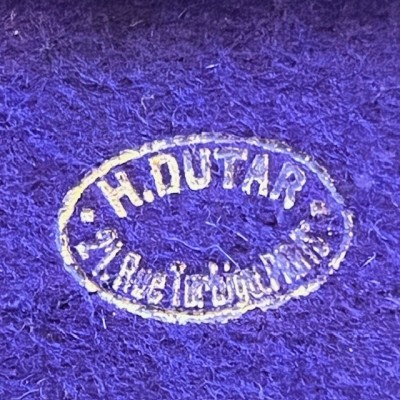- New












Dr Potain vacuum cleaner in its case
Early 20th century - 1900
Antique medical instrument from manufacturer H.DUTAR in Paris
Dr. Potain's aspirator in its felt case
Early 20th century - 1900
By surgical instrument manufacturer H.DUTAR, 21 rue de Turbigo, Paris. Manufacturer active around 1907/1910
This instrument was used to remove fluids, particularly in cases of pleurisy, which is an inflammation of the pleura, the membrane surrounding the lungs, and which often causes fluid to build up in the pleural cavity.
It could also be used to remove urine from a retained bladder or gas from an intestine strangulated by a hernia. However, it could also be used to inject fluid.
(Source: Rennes Hospital Heritage Conservatory).
The box is complete, but the rubber tubes have not survived the passage of time; the rubber has hardened and breaks into small pieces when handled.
Includes:
-A steel pump with two nozzles at the end.
-A hollow metal rod with two channels branching into two branches, each equipped with a tap.
-Trocar needles of different sizes, cannulas, and blunt punches.
-1 glass tube that contained the metal wires for cleaning the needles is located in the compartment under the trocars.
Case dimensions: 27.5 x 12 x 5.5 cm: in good condition, case lined with purple velvet inside.
H.DUTAR marking on the interior felt.
Case covered with black grained leather exterior with hot-stamped piping on the top. Push-button lock. Typical of cases produced between 1870 and 1910.
Antique ampoule for hypodermic injection
Histogénol - (circa 1900)
Antique glass dropper in white glass
Apothecary - Pharmacy
Heart-shaped stopper
Le corps de l'Homme
Anatomical colour plates with cut-out superimposed leaves
By Edmond Perrier - Schleicher Frères & Cie Editeurs
No date, circa 1900
T.NOIROT extract - Artificial peach cream
Antique pharmacy bottle - Apothecary
Central Pharmacy of the Civil Hospitals of Paris
Antique pharmacy bottle
Apothecary
English Litharge - POISON - Lead oxide
Nineteenth-century medicine bottle with beautiful black and gold label
Blown glass
Aqua Piris - Pear water
Antique pharmacy jar
Apothecary
Bulb for hypodermic injection - Camphor (circa 1920)
various manufacturers
Potion N°
Antique pharmacy bottle
Apothecary vial
There is still some product left, but the cap is stuck
Antique brass and cast-iron rack-and-pinion microscope in wooden case
Late 19th century - Early 20th century
Grams / Teaspoons in French: Grammes / Cuillères à café
Antique medicine bottle
Apothecary
Antique glass dropper in white glass
Apothecary - Pharmacy
Antique glass dropper in white glass - 30ml
Apothecary - Pharmacy
Heart-shaped stopper
Alcool fin dénaturé
Antique pharmacy bottle - Apothecary
EMPTY
70° alcohol
Antique pharmacy bottle - Apothecary
Mrs Bataille-Simon, First Class Pharmacist in Beaumont sur Sarthe - Tel 9
Violet de Méthyle
Antique pharmacy bottle - Droguerie - Apothicaire

Dr Potain vacuum cleaner in its case
Early 20th century - 1900
Antique medical instrument from manufacturer H.DUTAR in Paris











